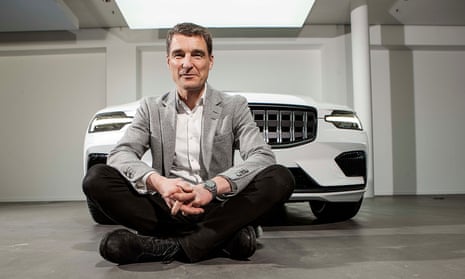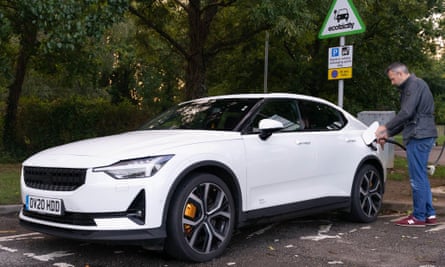
The Swedish-based electric carmaker has pulled ahead of rivals thanks to its no-factory model and Chinese partner, but its boss want to remove carbon from the production process too
“I was never ever that car guy who was interested in designing a Ferrari,” says Thomas Ingenlath. It’s a surprising thing to hear from a former designer for Audi, Skoda and Volvo. It makes more sense for the chief executive of an electric car startup, Polestar, launched in 2017 as a subsidiary brand of Volvo.
Ingenlath’s design ideals stretch way beyond car marques to include Apple products and high-end sports clothing.
The attraction of cars was that they were “almost like architecture” or “attractive, appealing sculptures”, says Ingenlath, on a video call from the company’s headquarters in Gothenburg, Sweden. Other influences he cites include the elegant but functional products made by the Bauhaus and Ulm design movements.
Polestar was clearly too good an opportunity to miss for Ingenlath, who became chief executive in 2017 after five years as head of design for Volvo. He says being freed from the history of a venerable brand allows Polestar to be “a bit more provocative, more exclusive, more performance-oriented … a little bit less Swedish”.
Still, it is a competitive field. The battery revolution has given the car industry the chance to build new brands around sleek electric technology, ranging from Tesla and Lucid to Chinese rivals such as Nio and Xpeng. Polestar is part of Chinese carmaking group Zhejiang Geely, and its stablemates, with which it shares much underlying technology, include Volvo, UK-based Lotus, and London Electric Vehicle Company, a taxi-maker.
This means Polestar differs from many of its competitors in operating on an asset-light business model, with only 2,500 employees globally. A thousand of these are in Gothenburg, and about 300 are in the UK, developing the Polestar 5 saloon car. Normally a single factory employs thousands, but Polestar’s vehicles are manufactured in Geely plants in Chengdu and Hangzhou in China and, for the £80,000 Polestar 3 SUV, Volvo’s factory in South Carolina.
The no-factories model has been the key to Polestar being able to develop five models so quickly. In June, the company raised $1bn in a merger with a cash shell on New York’s Nasdaq stock exchange, but that is significantly less than would be expected for the creation of five new cars. Profitability is on the horizon in 2024 or 2025, and Ingenlath is hoping to sell 290,000 cars in 2025, 10 times what the company managed in 2021.
“We never, ever could do that on our own within our R&D team,” he says.
Polestar is Ingenlath’s first true foray beyond the design studio, after a career that has crisscrossed Europe. He grew up in the west of Germany, near the Dutch border, where his father worked in a post office. His parents pushed for him to have a university education – a drive that Ingenlath partly ascribes to his mother, who as a child had fled Poland with her mother and her sister during the second world war as the Russians invaded.
“Not being able to have a really good school education [because of the war] was a big driver for her having such a high focus on her children getting that opportunity,” he says. His decision – after a teacher’s intervention – to train as a designer rather than a doctor or a lawyer was “superfrightening for my parents”, he adds.
Ingenlath normally speaks at a measured, calm pace, but talking about that period prompts longer pauses. “It was … it was not easy,” he says. “It was not till years later that they realised that that actually was not just a crazy decision, but something meaningful.”

His design studies took him to Pforzheim in south-west Germany and then to London’s Royal College of Art. From there he joined the car industry, starting at Audi in Bavaria. In 1999 Ingenlath became head of design for VW’s Skoda brand, and in 2012 he moved to Volvo.
Despite – or perhaps because of – the years he has spent in the car industry, Ingenlath is strongly convinced of the need for change. “I still get the shivers when I see some of the advertisements out there,” he says. But it is not just branding that needs to move on: he believes the automotive industry will very soon have to face up to its entire environmental footprint. That means eliminating carbon emissions from the production process as well as from the vehicles.
The sprawling Dieselgate scandal, in which Volkswagen and others installed software to cheat emissions tests, is one of the reasons he has started a “0 project” – with the aim of producing a Polestar car with no associated carbon emissions.
“The burden that we have as a car industry is what happened over the last decades,” said Ingenlath. “And having lost all that trustworthiness and trust from the consumer, I think we can’t risk to lose that again.”
Yet new technologies are not just about industry atonement. They also offer an exciting opportunity for carmakers. Polestar is swapping the ever-unsatisfying rear window for cameras in its 5, and air intakes needed for internal combustion engines have been swapped for sensors that will enable gradually improving autonomous driving . Inside, there is no central driveshaft, and touchscreens have replaced much of the aircraft-style “cockpit” of old. Ingenlath says the central importance of the software experience on those screens is still not recognised by many car brands.
The conversation returns again and again to design. Ingenlath admits that he sometimes feels “a bit sentimental” when visiting the design studio, but insists that being chief executive – with all of the worries of financing, operations and leadership of thousands – still offers similar stimulations to the design tasks that first drew him to the car industry.
“I think the day job still has enough creative challenges for me to have a happy life here,” he says.
CV
Age 58
Family Lives in Gothenburg with his wife and three children.
Education Undergraduate degree in transportation design from Pforzheim University, and an MA in vehicle design from London’s Royal College of Art.
Pay He declines to comment. The UK holding company has yet to file its first annual report.
Last holiday “Sailing up the Swedish coast.”
Best advice he’s been given When I took the job at Volvo, former Porsche design boss Harm Lagaay told me to make the most of my first year there: “Whatever big changes you want to introduce, use the first year. After that it will be much harder to do it.”
How he relaxes Riding his bike home from work.
Phrase he overuses “Why not?”
Biggest career mistake “Life is a lesson – you’ve learned it when you’re through. Yesterday’s ‘mistake’ might be the reason for today’s success, and in that light shouldn’t be judged a mistake.”